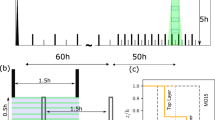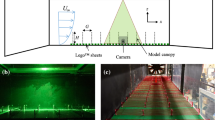Abstract
Boundary layer interactions with canopies control various environmental processes. In the case of dense and homogeneous canopies, the so-called mixing layer analogy is most generally used. When the canopy becomes sparser, a transition occurs between the mixing layer and the boundary layer perturbed by interactions between element wakes. This transition has still to be fully understood and characterized. The experimental work presented here deals with the effect of the canopy density on the flow turbulence and involves an artificial canopy placed in a fully developed turbulent boundary layer. One and two-component velocity measurements are performed, both within and above the canopy. The influence of the spacing between canopy elements is studied. Longitudinal velocity statistical moments and Reynolds stresses are calculated and compared to literature data. For spacings greater than the canopy height, evidences of this transition are found in the evolution of the skewness factor, shear length scale and mixing length.
Similar content being viewed by others
References
Amiro BD (1990) Comparison of turbulence statistics within three boreal forest canopies. Boundary-Layer Meteorol 51(1–2): 99–121. doi:10.1007/BF00120463
Aubrun S, Leitl B (2004) Development of an improved physical modelling of a forest area in a wind tunnel. Atmos Environ 38(18): 2797–2801. doi:10.1016/j.atmosenv.2004.02.035
Baldocchi DD, Hutchinson BA (1987) Turbulence in an almond orchard: vertical variations in turbulent statistics. Boundary-Layer Meteorol 40(1-2): 127–146. doi:10.1007/BF00140072
Belcher SE, Jerram N, Hunt JCR (2003) Adjustment of a turbulent boundary layer to a canopy of roughness elements. J Fluid Mech 488: 369–398. doi:10.1017/S0022112003005019
Britter RE, Hanna SR (2003) Flow and dispersion in urban areas. Annu Rev Fluid Mech 35: 469–496. doi:10.1146/annurev.fluid.35.101101.161147
Brunet Y, Finnigan JJ, Raupach MR (1994) A wind tunnel study of air flow in waving wheat: single-point velocity statistics. Boundary-Layer Meteorol 70(1-2): 95–132. doi:10.1007/BF00712525
Brunet Y, Irvine MR (2000) The control of coherent eddies in vegetation canopies: streamwise structure spacing, canopy shear scale and atmospheric stability. Boundary-Layer Meteorol 94(1): 139–163. doi:10.1023/A:1002406616227
Cheng H, Castro IP (2002) Near-wall flow over urban-like roughness. Boundary-Layer Meteorol 104(2): 229–259. doi:10.1023/A:1016060103448
Cionco RM (1972) A wind-profile index for canopy flow. Boundary-Layer Meteorol 3(2): 255–263. doi:10.1007/BF02033923
Cionco RM (1978) Analysis of canopy index values for various canopy densities. Boundary-Layer Meteorol 15(1): 81–93. doi:10.1007/BF00165507
Finnigan JJ (2000) Turbulence in plant canopies. Annu Rev Fluid Mech 32: 519–571. doi:10.1146/annurev.fluid.32.1.519
Ghisalberti M, Nepf H (2006) The structure of the shear layer in flows over rigid and flexible canopies. Environ Fluid Mech 6(3): 277–301. doi:10.1007/s10652-006-0002-4
Green SR, Grace J, Hutchings NJ (1995) Observations of turbulent air flow in three stands of widely spaced Sitka spruce. Agric Meteorol 74(3-4): 205–225. doi:10.1016/0168-1923(94)02191-L
Grimmond CSB, Oke TR (1999) Aerodynamic properties of urban areas derived from analysis of surface form. J Appl Meteorol 38(9): 1262–1292. doi:10.1175/1520-0450(1999)038<1262:APOUAD>2.0.CO;2
Irvine MR, Gardiner BA, Hill MK (1997) The evolution of turbulence across a forest edge. Boundary-Layer Meteorol 84(3): 467–496. doi:10.1023/A:1000453031036
Kaimal JC, Finnigan JJ (1994) Atmospheric boundary layer flows: their structure and measurement. Oxford University Press, New York
Macdonald RW (2000) Modelling the mean velocity profile in the urban canopy layer. Boundary-Layer Meteorol 97(1): 25–45. doi:10.1023/A:1002785830512
Massman WJ (1987) A comparative study of some mathematical models of the mean wind structure and aerodynamic drag of plant canopies. Boundary-Layer Meteorol 40(1-2): 179–197. doi:10.1007/BF00140075
Massman WJ (1997) An analytical one-dimensional model of momentum transfer by vegetation of arbitrary structure. Boundary-Layer Meteorol 83(3): 407–421. doi:10.1023/A:1000234813011
Meroney RN (1968) Characteristics of wind and turbulence in and above model forests. J Appl Meteorol 7(5): 780–788. doi:10.1175/1520-0450(1968)007<0780:COWATI>2.0.CO;2
Monismith SG (2007) Hydrodynamics of coral reefs. Annu Rev Fluid Mech 39: 37–55. doi:10.1146/annurev.fluid.38.050304.092125
Nepf H (1999) Drag, turbulence and diffusion in flow through emergent vegetation. Water Resour Res 35(2): 479–489. doi:10.1029/1998WR900069
Nepf H, Ghisalberti M, White B, Murphy E (2007) Retention time and dispersion associated with submerged aquatic canopies. Water Resour Res 43((4): W0422. doi:10.1029/2006WR005362
Novak MD, Warland JS, Orchansky AL, Ketler R, Green S (2000) Wind tunnel and field measurements of turbulent flow in forests. Part I : uniformly thinned stands. Boundary-Layer Meteorol 95(3): 457–495. doi:10.1023/A:1002693625637
Petroff A, Mailliat A, Amielh M, Anselmet F (2008) Aerosol dry deposition on vegetative canopies. Part I: review of present knowledge. Atmos Environ 42(16): 3625–3653. doi:10.1016/j.atmosenv.2007.09.043
Petroff A, Mailliat A, Amielh M, Anselmet F (2008) Aerosol dry deposition on vegetative canopies. Part II: a new modelling approach and applications. Atmos Environ 42(16): 3654–3683. doi:10.1016/j.atmosenv.2007.12.060
Pietri L, Amielh M, Anselmet F (2006) Effect of the vegetation density on the turbulence properties in a canopy flow. In 13th international symposium on applications of laser techniques to fluid mechanics, 26–29 June, Lisbon, Portugal. http://ltces.dem.ist.utl.pt/lxlaser/lxlaser2006/program.asp
Poggi D, Porporato A, Ridolfi L, Albertson JD, Katul GG (2004) The effect of vegetation density on canopy sub-layer turbulence. Boundary-Layer Meteorol 111(3): 565–587. doi:10.1023/B:BOUN.0000016576.05621.73
Pope SB (2000) Turbulent flows. Cambridge University Press,
Py C, de Langre E, Moulia B (2006) A frequency lock-in mechanism in the interaction between wind and crop canopies. J Fluid Mech 568: 425–449. doi:10.1017/S0022112006002667
Raupach MR, Antonia RA, Rajagopalan S (1991) Rough-wall turbulent boundary layers. Appl Mech Rev 44(1): 1–25
Raupach MR, Coppin PA, Legg BJ (1986) Experiments on scalar dispersion within a model plant canopy. Part I: the turbulence structure. Boundary-Layer Meteorol 35(1-2): 21–52. doi:10.1007/BF00117300
Raupach MR, Finnigan JJ, Brunet Y (1996) Coherent eddies in vegetation canopies: the mixing layer analogy. Boundary-Layer Meteorol 78(3-4): 351–382. doi:10.1007/BF00120941
Raupach MR, Hughes DE, Cleugh HA (2006) Momentum absorption in rough-wall boundary layers with sparse roughness elements in random and clustered distributions. Boundary-Layer Meteorol 120(2): 201–218. doi:10.1007/s10546-006-9058-4
Righetti M, Armanini A (2002) Flow resistance in open channel flows with sparsely distributed bushes. J Hydrol (Amst) 269(1–2): 55–64. doi:10.1016/S0022-1694(02)00194-4
Ruijgrok W, Tieben H, Eisinga P (1997) The dry deposition of particles to a forest canopy: a comparison of model and experimental results. Atmos Environ 31(3): 399–415. doi:10.1016/S1352-2310(96)00089-1
Scurlock JMO, Asner GP, Gower ST (2001) Worlwide historical estimates of leaf area index, 1932–2000. Report ORNL/TM-2001/268, Oak Ridge National Laboratory, U.S.A.
Shaw RH, Irvine I (1987) Calculation of velocity skewness in real and artificial canopies. Boundary-Layer Meteorol 39(4): 315–332. doi:10.1007/BF00125141
Shaw RH, Tavangar J, Ward DP (1983) Structure of the Reynolds stress in a canopy layer. J Clim Appl Meteorol 22: 1922–1931. doi:10.1175/1520-0450(1983)022<1922:SOTRSI>2.0.CO;2
Slinn WGN (1982) Prediction for particle deposition to vegetative canopies. Atmos Environ 16: 1785–1794. doi:10.1016/0004-6981(82)90271-2
Wieringa J (1993) Representative roughness parameters for homogeneous terrain. Boundary-Layer Meteorol 63(4): 323–363. doi:10.1007/BF00705357
Zhu W, van Hout R, Luznik L, Kang HS, Katz J, Meneveau C (2006) A comparison of PIV measurements of canopy turbulence performed in the field and in a wind tunnel model. Exp Fluids 41(2): 309–318. doi:10.1007/s00348-006-0145-6
Author information
Authors and Affiliations
Corresponding author
Rights and permissions
About this article
Cite this article
Pietri, L., Petroff, A., Amielh, M. et al. Turbulence characteristics within sparse and dense canopies. Environ Fluid Mech 9, 297–320 (2009). https://doi.org/10.1007/s10652-009-9131-x
Received:
Accepted:
Published:
Issue Date:
DOI: https://doi.org/10.1007/s10652-009-9131-x




